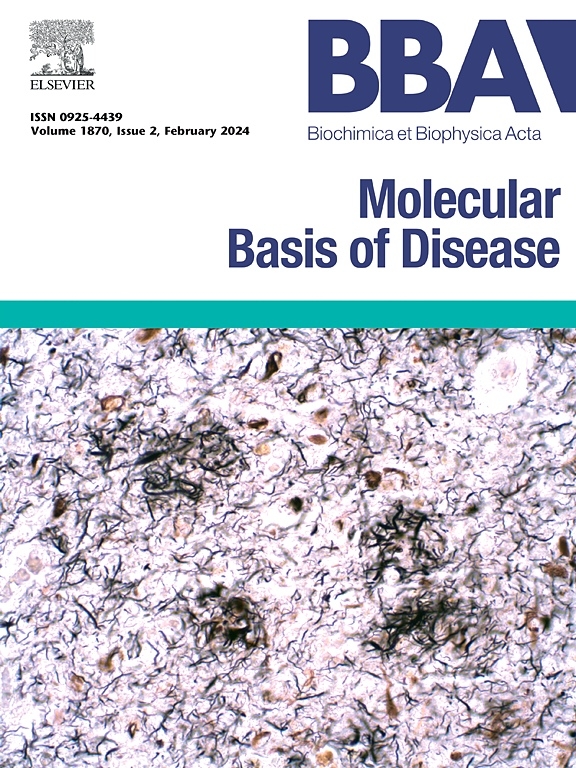mettl1介导的m7G修饰NEK1 mRNA促进口腔鳞状细胞癌的增殖
IF 4.2
2区 生物学
Q2 BIOCHEMISTRY & MOLECULAR BIOLOGY
Biochimica et biophysica acta. Molecular basis of disease
Pub Date : 2025-06-23
DOI:10.1016/j.bbadis.2025.167961
引用次数: 0
摘要
口腔鳞状细胞癌(OSCC)是头颈部最常见的恶性肿瘤,是一个重要的公共卫生问题。7-甲基鸟苷酸(m7G) RNA修饰是一种新发现的影响基因表达的调控机制,甲基转移酶样1 (METTL1)与多种癌症的肿瘤进展有关;然而,它在OSCC中的具体作用在很大程度上仍未被探索。本研究显示,METTL1在OSCC中表达显著升高,且与患者预后不良相关。功能分析表明,在实验室环境和动物模型中,降低METTL1水平可抑制OSCC细胞增殖,导致G1期细胞周期阻滞。为了更深入地研究其作用机制,我们利用m7G甲基化RNA免疫沉淀测序(m7G MeRIP-seq)和RNA测序(RNA-seq)来确定OSCC细胞中METTL1的下游靶点。我们的研究结果证实,mettl1催化m7G修饰NEK1 mRNA的5 ‘非翻译区(5 ’ utr)增强了NEK1 mRNA的稳定性,并积极调节NEK1的表达。此外,沉默NEK1也抑制OSCC细胞增殖,减少克隆形成,并诱导G1期细胞周期阻滞。这些发现表明,mettl1介导的m7G修饰对OSCC增殖至关重要,NEK1被认为是一个重要的下游靶点。综上所述,METTL1作为OSCC的潜在预后标志物和治疗靶点,突出了其分子机制和临床意义的进一步探索的必要性。本文章由计算机程序翻译,如有差异,请以英文原文为准。
METTL1-mediated m7G modification of NEK1 mRNA promotes the proliferation of oral squamous cell carcinoma
Oral squamous cell carcinoma (OSCC) is the most common malignant tumor found in the head and neck region, representing a significant public health concern. The 7-methylguanylate (m7G) RNA modification is a newly recognized regulatory mechanism influencing gene expression, and methyltransferase-like 1 (METTL1) has been linked to tumor progression in various cancers; however, its specific role in OSCC remains largely unexplored. This study reveals that METTL1 expression is notably increased in OSCC and correlates with a poor prognosis for patients. Functional assays indicate that reducing METTL1 levels inhibits OSCC cell proliferation both in laboratory settings and in animal models, resulting in a G1 phase cell cycle arrest. To delve deeper into the mechanisms at play, we utilized m7G Methylated RNA Immunoprecipitation Sequencing (m7G MeRIP-seq) alongside RNA sequencing (RNA-seq) to pinpoint the downstream targets of METTL1 in OSCC cells. Our results confirm that METTL1-catalyzed m7G modification on the 5′ untranslated region (5’UTR) of NEK1 mRNA enhances its stability and positively regulates NEK1 expression. Additionally, silencing NEK1 also inhibits OSCC cell proliferation, diminishes clonogenic formation, and induces G1 phase cell cycle arrest. These findings indicate that METTL1-mediated m7G modification is vital for OSCC proliferation, with NEK1 identified as a significant downstream target. In conclusion, METTL1 stands out as a potential prognostic marker and therapeutic target in OSCC, highlighting the need for further exploration of its molecular mechanisms and clinical implications.
求助全文
通过发布文献求助,成功后即可免费获取论文全文。
去求助
来源期刊
CiteScore
12.30
自引率
0.00%
发文量
218
审稿时长
32 days
期刊介绍:
BBA Molecular Basis of Disease addresses the biochemistry and molecular genetics of disease processes and models of human disease. This journal covers aspects of aging, cancer, metabolic-, neurological-, and immunological-based disease. Manuscripts focused on using animal models to elucidate biochemical and mechanistic insight in each of these conditions, are particularly encouraged. Manuscripts should emphasize the underlying mechanisms of disease pathways and provide novel contributions to the understanding and/or treatment of these disorders. Highly descriptive and method development submissions may be declined without full review. The submission of uninvited reviews to BBA - Molecular Basis of Disease is strongly discouraged, and any such uninvited review should be accompanied by a coverletter outlining the compelling reasons why the review should be considered.

 求助内容:
求助内容: 应助结果提醒方式:
应助结果提醒方式:


